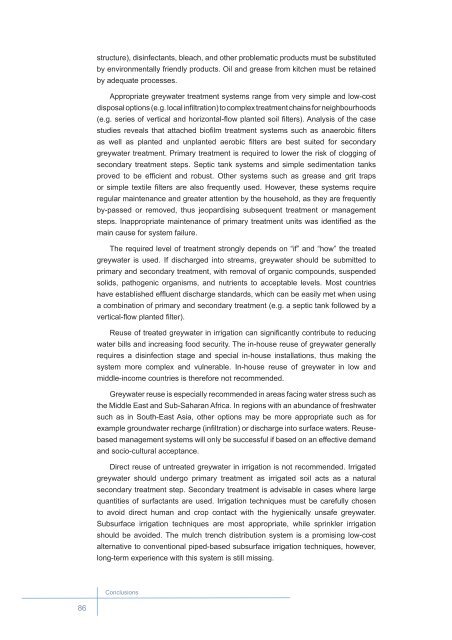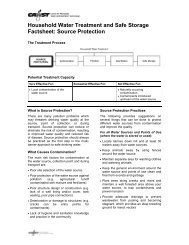Greywater Management in Low and Middle-Income Countries - SSWM
Greywater Management in Low and Middle-Income Countries - SSWM
Greywater Management in Low and Middle-Income Countries - SSWM
Create successful ePaper yourself
Turn your PDF publications into a flip-book with our unique Google optimized e-Paper software.
structure), dis<strong>in</strong>fectants, bleach, <strong>and</strong> other problematic products must be substituted<br />
by environmentally friendly products. Oil <strong>and</strong> grease from kitchen must be reta<strong>in</strong>ed<br />
by adequate processes.<br />
Appropriate greywater treatment systems range from very simple <strong>and</strong> low-cost<br />
<br />
<br />
<br />
<br />
greywater treatment. Primary treatment is required to lower the risk of clogg<strong>in</strong>g of<br />
secondary treatment steps. Septic tank systems <strong>and</strong> simple sedimentation tanks<br />
<br />
<br />
regular ma<strong>in</strong>tenance <strong>and</strong> greater attention by the household, as they are frequently<br />
by-passed or removed, thus jeopardis<strong>in</strong>g subsequent treatment or management<br />
<br />
ma<strong>in</strong> cause for system failure.<br />
<br />
greywater is used. If discharged <strong>in</strong>to streams, greywater should be submitted to<br />
primary <strong>and</strong> secondary treatment, with removal of organic compounds, suspended<br />
solids, pathogenic organisms, <strong>and</strong> nutrients to acceptable levels. Most countries<br />
<br />
a comb<strong>in</strong>ation of primary <strong>and</strong> secondary treatment (e.g. a septic tank followed by a<br />
<br />
<br />
water bills <strong>and</strong> <strong>in</strong>creas<strong>in</strong>g food security. The <strong>in</strong>-house reuse of greywater generally<br />
requires a dis<strong>in</strong>fection stage <strong>and</strong> special <strong>in</strong>-house <strong>in</strong>stallations, thus mak<strong>in</strong>g the<br />
system more complex <strong>and</strong> vulnerable. In-house reuse of greywater <strong>in</strong> low <strong>and</strong><br />
middle-<strong>in</strong>come countries is therefore not recommended.<br />
<strong>Greywater</strong> reuse is especially recommended <strong>in</strong> areas fac<strong>in</strong>g water stress such as<br />
the <strong>Middle</strong> East <strong>and</strong> Sub-Saharan Africa. In regions with an abundance of freshwater<br />
such as <strong>in</strong> South-East Asia, other options may be more appropriate such as for<br />
<br />
based management systems will only be successful if based on an effective dem<strong>and</strong><br />
<strong>and</strong> socio-cultural acceptance.<br />
Direct reuse of untreated greywater <strong>in</strong> irrigation is not recommended. Irrigated<br />
greywater should undergo primary treatment as irrigated soil acts as a natural<br />
secondary treatment step. Secondary treatment is advisable <strong>in</strong> cases where large<br />
quantities of surfactants are used. Irrigation techniques must be carefully chosen<br />
to avoid direct human <strong>and</strong> crop contact with the hygienically unsafe greywater.<br />
Subsurface irrigation techniques are most appropriate, while spr<strong>in</strong>kler irrigation<br />
should be avoided. The mulch trench distribution system is a promis<strong>in</strong>g low-cost<br />
alternative to conventional piped-based subsurface irrigation techniques, however,<br />
long-term experience with this system is still miss<strong>in</strong>g.<br />
Conclusions<br />
86
















